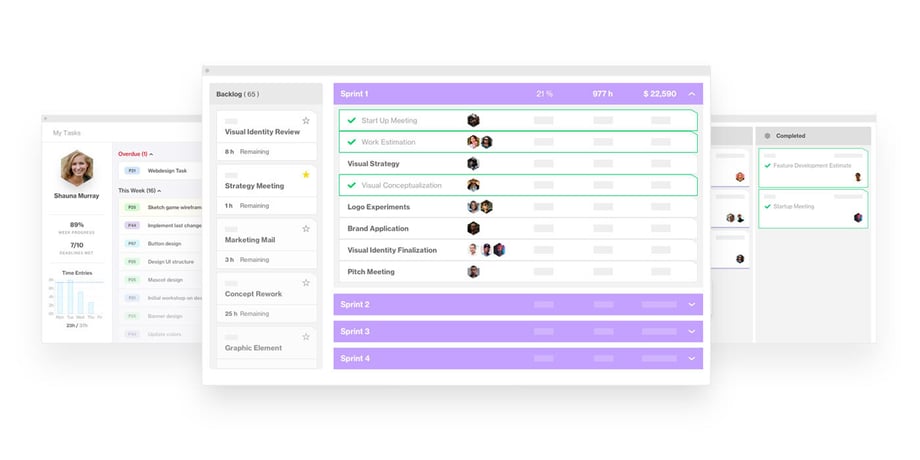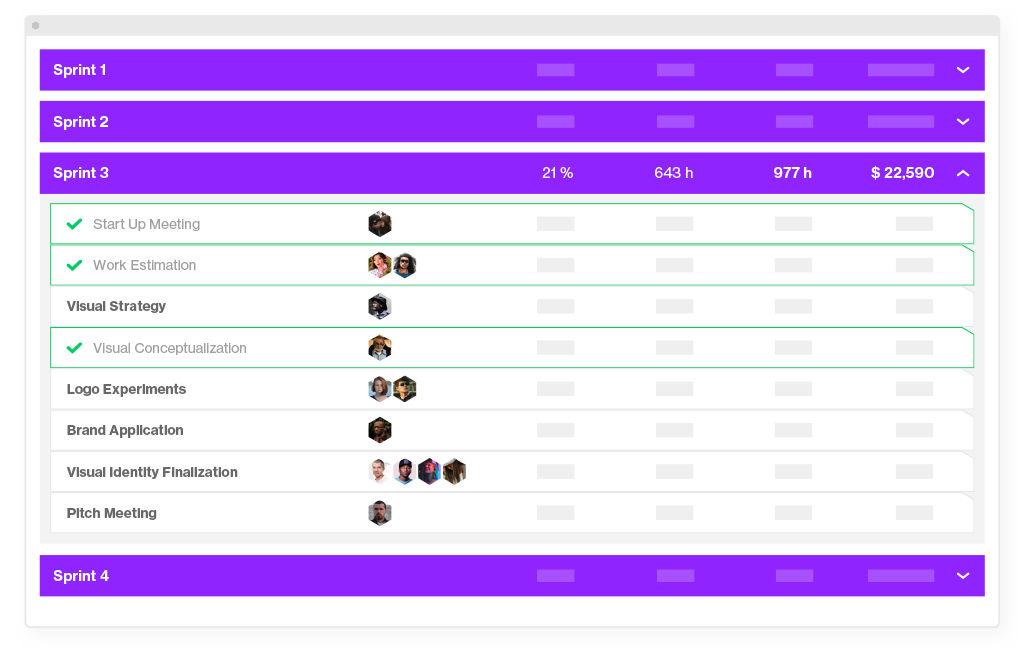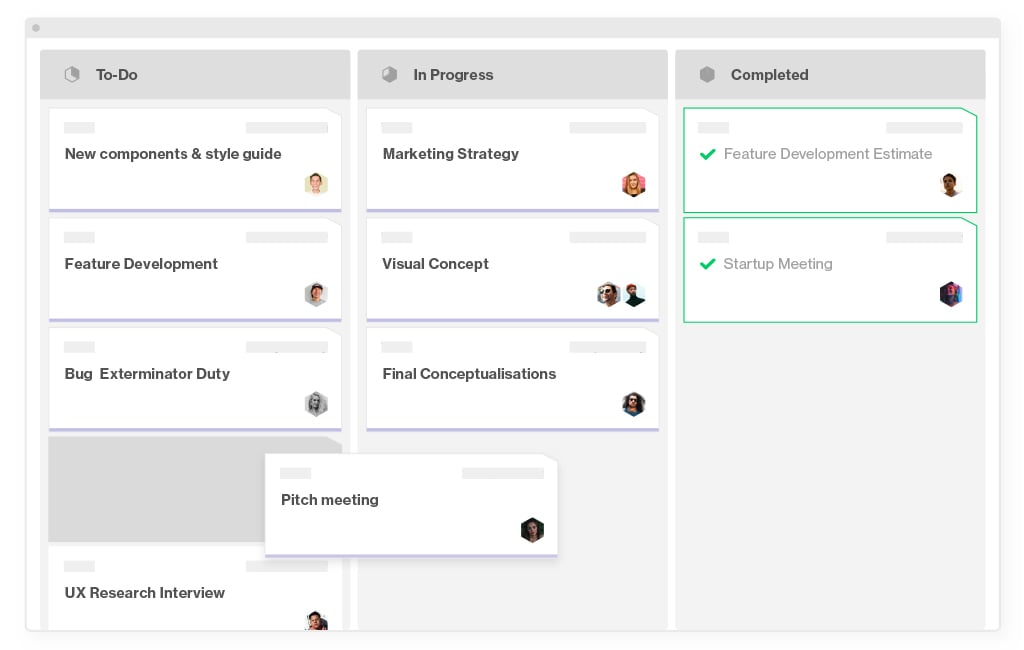What’s Agile Project Management Exactly?

Agile is one of the largest buzzwords of the IT improvement industry. Agile project management is really a value-driven approach that enables Project Managers to provide high-priority, top-quality work and look like rock stars to their stakeholders. It is nothing like the plodding, pricey, and error-prone method of project management that has shipped sporadic results for years. An agile project is finished in small sections known as iterations, with the team going through the same phases multiple times during the lifespan of the project. An iteration is usually scheduled to be completed within 2-4 weeks.
Ready to find out more? Below you’ll find everything there is to know about the agile project management methodology, so buckle up and enjoy the ride.
- The definition of agile project management
- Traditional vs agile project management
- Basic concepts of agile
- Agile ways of working
- Scrum: The ultimate agile methodology
- Kanban: A simple yet powerful framework
- Agile project management terms
- Benefits of agile
The definition of agile project management
Agile project management stands for an iterative approach to project delivery, which has been widely used in the past several years all around the world. In fact, recent research by the PMI found that 71% of organizations (which is almost three-quarters) use Agile approaches for their projects sometimes, often, or always. All the agile project management steps are part of the iterative ‘life cycles’, which bring teams closer to project completion. In simple terms, this means that each project gets broken down into short-term milestones or ‘iterations’.
The most common environment where you could see agile project management methods being applied are usually software development projects. Instead of following a linear path, those projects undergo frequent adjustments. And it is this adaptability that makes the approach so appealing to many companies these days. As for the aims and values that define agile project management, they are all about collaboration, flexibility, trust, and empowerment. Teams get the chance to enjoy benefits throughout the whole project rather than only at the end of the journey.

Traditional vs agile project management
Unlike agile project management principles, traditional project management is a tried and tested methodology that instructs all projects to follow a sequential cycle. With that cycle, there are 5 fixed project stages: initiation, planning, execution, monitoring, and closure. The main pillars of the traditional approach are linear processes, prioritization, and upfront planning. This, in turn, means that timing and budgeting can often cause project issues as you need to define and fix them prior to project launch. Here are the factors that still make the traditional approach a reasonable option for some companies:
- Predictable scheduling and costs
- Predictable delivery date
- Flexible prioritization
Unlike the traditional method, agile project management leaves you less room for upfront planning and prioritization as projects tend to be flexible in nature and prone to frequent adjustments. Every agile project management sprint marks a milestone where a small goal gets accomplished on the way to project completion.
Read more: 4 Ways Agile Is Different From Traditional Project Management
Among all the traditional methodologies, the waterfall model offers the most common and the most straightforward way to approach project management. It helps break projects into sequential phases with a new phase being launched only after you successfully complete the previous one. From the onset of the project, each member of the team knows exactly what their role in the project is. They all move towards a common goal, covering multiple phases which are not expected to undergo change when the project is already in progress.
ff78.jpg)
When you compare a typical waterfall project with an average agile project management example, the latter will have shorter cycles, overlapping work for teams and contributors, as well as frequent test runs and adaptations. With the waterfall approach, changes are not welcome because they usually turn out to cost a pretty penny. This is the very reason why this approach works best for the type of long projects that have a single timeline and are driven by detailed plans from the get-go.
Read more: Agile vs Waterfall: What's Best for Your Projects, Clients & Business?
Basic concepts of agile project management
Use these concepts to apply agile methods inside your projects:
- Deliver working software frequently, from a few days to a few several weeks, having a preference towards the shorter timescale.
- Business owners and designers must interact daily through the project. The focus is on teamwork!
- Build projects around motivated people. Provide them with a good working atmosphere and the support they need. Have confidence in them to complete the job.
- The best and efficient approach to offering information to and inside a team of developers is face-to-face conversation.
- Working software or completing work items is the main way of measuring progress.
- Agile processes promote sustainable development. The sponsors, designers, and customers should have the ability to conserve a constant pace indefinitely.
- Don't be afraid of change. Embrace changing requirements, both from stakeholders and clients.
Agile ways of working
You will find various methods which are collectively recognized as agile, as they endorse the values of the agile manifesto plus they're consistent with the above concepts. Typically the most popular ones are as follows:
DSDM - Dynamic Systems Development Method
DSDM is most likely the initial agile development method. DSDM was around prior to the term ‘agile’ being invented but is completely based on all of the concepts we have come to know as agile. DSDM appears to be more and more popular in the United Kingdom than in other places. It can work well with other methods such as PRINCE2.
Scrum
Scrum is also an agile method, which concentrates particularly on how to manage tasks inside a team-based atmosphere. Scrum is easily the most popular and broadly adopted agile method. This is due to its being very simple to apply while it also addresses most of the management problems that have affected IT development teams for many years.

Read more: Beginner's Guide to Agile with Scrum
XP - Extreme Programming
XP is really a more radical agile methodology, focusing more on the program engineering process plus addressing development as well as test phases along with novel approaches which make a considerable impact on quality as it involves pair programming and extensive code reviews. Thus its intended focus is to improve software quality and responsiveness to changing customer requirements.
Scrum: The ultimate agile methodology
Considering that most companies choose to do their agile project management with Scrum, let’s take a moment to look at it in more detail.
Scrum is the methodology that makes the history of agile project management and is still extensively used, decades after being first introduced. The fundamentals of the Scrum model revolve around effective communication among all team members. As a rule, every Scrum sprint starts with a short planning meeting and they also end it with a review.
When you think about it, there are quite a few features that explain why many teams find Scrum to be so appealing when looking for their perfect agile project management methodology. For one thing, the approach puts focus on the team and encourages lots of interaction, ridding people of the burden of extensive documentation. It also makes project completion easier by breaking it into short milestones, with each of them reaching a maximum of 30 days. These distinctive features explain why Scrum often gets cherry-picked for complex projects that breathe novelty and run on aggressive deadlines. If your team has to develop something unseen before and you are not completely sure what traps lie ahead, Scrum is that Agile in project management you’re looking for.
Read more: Implementation of Scrum - 7 Steps for an Effective Process
Kanban: A simple yet powerful framework
Scrum shares the pedestal of agile project management with Kanban, another popular framework. Kanban is often referred to as one of the agile project management tools, where you get to maximize efficiency, limit your work-in-progress, and visualize work. The system actually originates from a visual system of cards Toyota manufacturing once developed for production control.
Unlike Scrum, Kanban does not promote short cycles but focuses on developing one large project lifecycle instead. This means that few interruptions and transparent communication are crucial for project success with Kanban. You usually get there by making task cards and putting them in different columns, which usually mark your to-dos, things in progress, and completed tasks. Such a simple method helps you always know the status of each task and see when you can pick something new to work on from the pipeline. In short, you get faster turnaround, transparency, clear objectives, and flexible planning.

Read more: Getting Started With a Kanban Board: 6 Tips for Productive Work
Agile project management terms
Agile includes a number of different terms. These terms can be used in many different contexts, some projects will use them and some won't. The most used terms are:
- Scrum Master - The Scrum Master is a facilitator for the team and product owner. Rather than manage the team, the Scrum Master works to assist both the team and product owner.
- Product Owner - A single person that must have final authority representing the customer's interest in backlog prioritization and requirements questions.
- Team Member - A team member is defined as anyone working on sprint tasks toward the sprint goal.
- Release planning (Milestone) - The transition of an increment of potentially shippable product from the development team into routine use by customers. Releases typically happen when one or more sprints have resulted in the product having enough value to outweigh the cost to deploy it.
- Sprint - An iteration of work during which an increment of product functionality is implemented. Typically 2-4 weeks.
- Sprint planning - The Sprint planning meeting is a negotiation between the team and the product owner about what the team will do during the next sprint.
- Daily scrum - A fifteen-minute daily meeting where each team member briefly explains what they did yesterday, what they'll work on today, and if anything is preventing the team member from performing optimally.
- Sprint retrospective - The sprint retrospective meeting is held at the end of every sprint after the sprint review meeting. The team and ScrumMaster meet to discuss what went well and what to improve in the next sprint.
- Impediments - Anything that prevents a team member from performing work as efficiently as possible is an impediment.
- Backlog - The product backlog (or "backlog") is the requirement for a system, expressed as a prioritized list of product backlog Items. These included both functional and non-functional customer requirements, as well as technical team-generated requirements.
- Product Backlog Item - A product backlog item ("PBI", "backlog item", "item", "story", or "user story") is a unit of work small enough to be completed by a team in one Sprint iteration. Backlog items are decomposed into one or more tasks.
- Task - A task (or sprint task) is a unit of work generally between four and sixteen hours. Team members volunteer for tasks. They update the estimated number of hours remaining on a daily basis, influencing the sprint burndown chart. Tasks are contained by backlog items. It's encouraged to split a task into several if the estimate exceeds twelve hours.
Read more: Why You Should Work in Sprints
Benefits of agile
- The major benefit of agile project management is being able to react to issues as they become apparent. New things will constantly arise throughout any project and working on the right things is even more important today than it has ever been.
- Switching to a more important task at the right time can help save assets and, ultimately, help deliver an effective project promptly and within budget.
- Agile project management reduces complexity by breaking the whole project into short iterations instead of lengthy and comprehensive needs for the entire project to be planned up-front.
- Agile project management constantly evaluates cost and time as primary constraints. Quick feedback, continuous adjustment, and QA guidelines are built-in, so teams can be committed, making it certain that top-quality outputs are produced.
- By getting greater visibility plus continuous feedback, the agile PMs and PMOs can respond very rapidly to change direction and remove bottlenecks within the process, delivering superior software, faster.
To get the most out of Agile, many teams go for the old classic Jira to organize their work. However, while it is indeed reliable agile project management software, there are more advanced options available. Project managers question Jira because it complicates resource allocation, reporting, and budgeting. Being cut off from the big picture and trying to figure out where the wind blows from is just not going to do it anymore. That’s why it’s reasonable to take the best things Jira has to offer and combine them with the most innovative AI-driven agile project management tools.
Read more: The Connected Value of Forecast & Jira in Project Management
Finally, agile project management is a very exciting and invigorating approach, even though some projects suit agile better than others. The collaboration and visibility agile offers can show a significantly more rewarding experience for teams to output their best work faster. For many, agile is also a more enjoyable way of working compared to the more traditional waterfall approach, which requires much more documentation and it is less flexible by its nature. If you want to see how agile project management can revolutionize your projects and are looking for the best tool to back you up in this, don’t hesitate to sign up for a free trial with Forecast today!
You might like to read these articles on our blog..
Subscribe to the Forecast Newsletter
Get a monthly roundup of productivity tips & hacks delivered straight to your inbox


